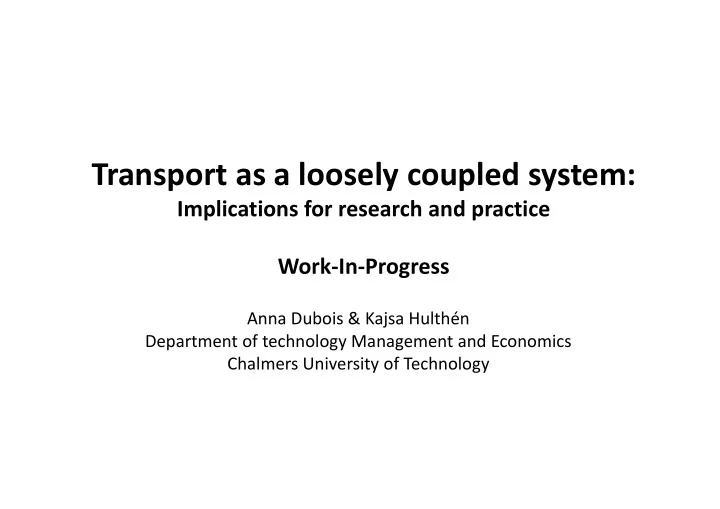

Transport as a loosely coupled system: Implications for research and practice Work-In-Progress Anna Dubois & Kajsa Hulthén Department of technology Management and Economics Chalmers University of Technology
Background • Why is the transport system so hard to change? • The transport system is a complex open system consisting of a number of layers that interconnects through a number of interfaces
Transport in context The transport system The actual Exchange of transport goods Supply chain layer Interface: Exchange of transport services Transport layer Interface: Traffic – use of transport infrastructure Infrastructure layer The physical transport infrastructure Source: Modified from OECD Report (1992)
Loosely coupled systems Enligt Weick (1976): “ loosely coupled events are responsive, but each event also preserves its own identity and some evidence of its physical or logical separateness” Potential functions and dysfunction of loose couplings: Localised adaptations • Sensing mechanisms • Variation generation • Self-determination • Seal of and prevent problems • Preservation • Inexpensive to run •
Aim To analyse the organising of the transport system with regard to the • pattern of loose and tight couplings: What elements are loosely coupled? • What domains are they coupled on? • What are the characteristics of the couplings and de-coupling? • What are the consequences of these patterns of couplings? • – for research, practice and policy
General pattern of couplings Domain: Elements Couplings System layer/ Interface Supply chain Actors, activities, resources Tight - integrated supply chains of buyers and suppliers of subject to interdependence goods Exchange of Activities and resources of Loose – transactional, independent transport services buyers and suppliers of (Tight when subject to special transport services arrangements) Adjustments to… Transport Operations of vehicles for Loose goods transport (Tight when vehicles are adjusted to special goods/cargo) Traffic Connections between Loose for road transport vehicles and physical Tight for rail, sea and air infrastructures Infrastructure Physical transport Tight - subject to standards and infrastructure components long term investments
Implications • Research at the respective system layers remains separated - need to proceed across layers/interfaces? • Demonstration and implementation projects need to take into consideration couplings beyond the project boundary • How can the current pattern of couplings explain successes and failures in attempts to effectuate changes/innovate in the transport system? • (How) Can transport efficiency and effectiveness be improved by altered patterns of loose and tight couplings?
Recommend
More recommend